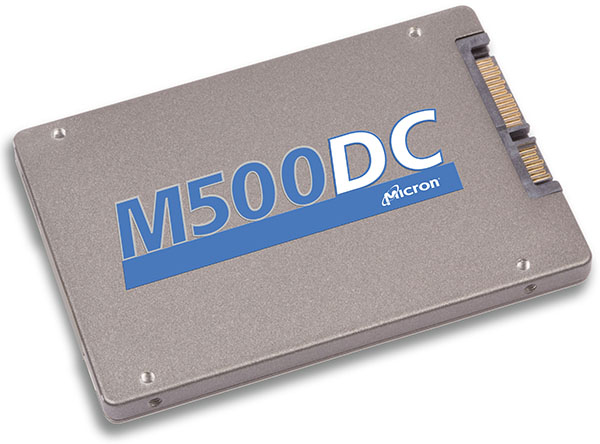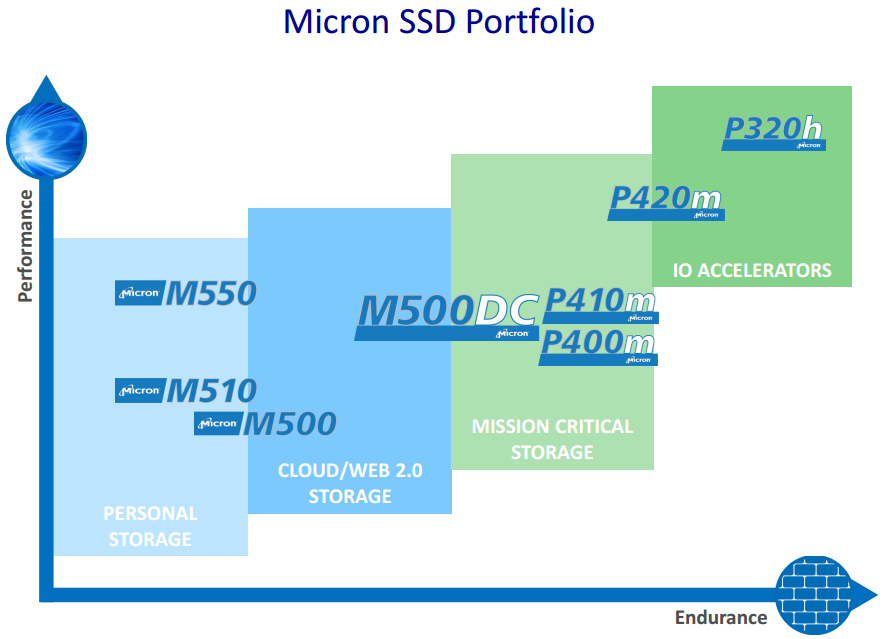Micron M500DC 800 GB SSD Review: Cloud And Web 2.0 Storage
Building on the desktop-oriented M500, Micron is announcing its enterprise-focused M500DC. We got a chance to run the 800 GB model through an updated test suite to gauge whether this Marvell-powered SSD keeps up with the best-known enterprise solutions.
Bridging The Gap Between Consumer And Enterprise Storage
With the release of its M500DC, Micron continues a trend we've seen a lot of lately: dividing the SSD space into smaller pieces serviced by more purpose-built products. The relevant players take different approaches to this. For example, Intel cost-reduces its high-end enterprise drives, while Samsung adds enterprise-oriented features to its consumer architecture. Micron's M500DC takes the latter approach, incorporating higher-end functionality on a more desktop-class drive, rather than building a P400m (Micron P400m SSD Review: High Endurance MLC Is Here To Stay) with less expensive NAND.
The M500 and its nearly-identical, Crucial-branded cousin offered good performance, large capacities, and reasonable pricing. In fact, you'll still find M500s in Best SSDs For The Money. And while Crucial went after cost-conscious consumers, Micron pushed its M500 at entry-level, read-focused enterprise customers. The M500DC fills a gap for the company between its M500 and P400m. Micron achieves this in much the same way as SanDisk (formerly SMART), taking 20 nm MLC NAND and applying a healthy dose of semiconductor and firmware know-how to stretch the attributes that matter for more demanding enterprise-focused customers.
Although Micron calls the segment it's targeting "Cloud/Web 2.0 Storage", a more general description would be a mixed-workload environment. The M500DC's endurance rating places it in front of read-focused SSDs with origins in the consumer space, while still clearly behind eMLC- and SLC-based drives. Not many SSDs fit that exact description, so comparisons are difficult. And this takes us back to advice we give over and over: know your workload. The more granular you get in predicting what your application does with storage, the better you can optimize total cost of ownership.
| Micron M500DC | ||||
|---|---|---|---|---|
| User Capacity | 120 GB | 240 GB | 480 GB | 800 GB |
| Interface | 6 Gb/s SATA | |||
| Form Factor | 2.5" 7 mm / 1.8" 5 mm | |||
| Sequential Read | 425 MB/s | |||
| Sequential Write | 200 MB/s | 330 MB/s | 375 MB/s | |
| 4 KB Random Read | 63,000 IOPS | 65,000 IOPS | ||
| 4 KB Random Write | 23,000 IOPS | 33,000 IOPS | 35,000 IOPS | 24,000 IOPS |
| Power Consumption(Active Max) | 4 W | 5 W | 6 W | 6.2 W |
| Endurance (TBW) | 0.5 PB | 1.0 PB | 1.9 PB | 1.9PB |
Looking over its specifications, you can see that the M500DC is more than just a read-focused enterprise SSD. Write endurance falls between one to two Drive Writes per Day (DWPD), which is four to seven times higher than what you get from repurposed desktop technology, but below the 10 DWPD you'd see from Intel's SSD DC S3700 or Micron's P400m. It comes close to SanDisk and its Optimus Eco family, which is rated at 3 DWPD.
Topping out at 35,000 random write IOPS, the M500DC is also aligned with high-end enterprise SSDs. Unfortunately, read performance is a little underwhelming at 65,000 IOPS and 425 MB/s. Those are respectable numbers, but they're nowhere near the Optimus Eco and its 95,000 IOPS and 500 MB/s performance. They're also lower than most entry-level enterprise-oriented SSDs. We're not overly concerned yet, though. If you have a true mixed workload, the added write performance more than makes up for any shortcoming in read speed.
So, from a high level, the M500DC is set up to be more capable than most entry-level enterprise SSDs, but not as much so as the drives built to tolerate write-intensive tasks. For many of Micron's customers, price is going to determine which way they go. Unfortunately, as we often see, the company holds that information back. At higher capacities, however, we're expecting somewhere in the neighborhood of $1.15/GB, putting Micron's latest on par with Intel's SSD DC S3500. But let's see if we can form an opinion about the M500DC without the luxury of knowing what it costs.
Get Tom's Hardware's best news and in-depth reviews, straight to your inbox.
Current page: Bridging The Gap Between Consumer And Enterprise Storage
Next Page A Look Inside Micron's M500DC-
ParrLeyne Good article/review!Reply
Only one _small_ problem. According to the Micron product page (http://www.micron.com/products/solid-state-storage/enterprise-sata-ssd/m500dc-enterprise-sata-ssd) the M500DC is a SATA device, not SAS! -
tripleX The author obviously does not understand the subject matter. SAS lumped in with SATA? read-centric SSD isnt meant for read workloads? etc. numerous errors, too many to list.Reply -
tripleX Author does not understand what "corner case" is. corner case testing? are you doing lab validation work?Reply -
drewriley In SSD testing, it is common to call the mix in testing between read/write and random/sequential as '4 corner' or 'corner case' testing. And yes, this is lab verification work, that is kind of the point of the review. Also, SAS and SATA do compete for applications. The point was to put different product that had similar specifications against one another.Reply -
tripleX Reply13279486 said:In SSD testing, it is common to call the mix in testing between read/write and random/sequential as '4 corner' or 'corner case' testing. And yes, this is lab verification work, that is kind of the point of the review. Also, SAS and SATA do compete for applications. The point was to put different product that had similar specifications against one another.
The fact you are claiming this is anything even remotely near lab validation exposes your tremendous lack of knowledge on the subject.
No one refers to 4-corner testing as corner case testing. One link to a reputable site that does so? Instead of arguing an indefensible point you should be attempting to learn exactly what corner case means. Most would have had the good sense to do that before posting.
SAS v SATA is like Formula 1 compared to Go-Karts. Another example of your lack of understanding. SAS is meant for users who require certain features, and the price demands that users are aware of those features. They do not compete against each other, they are two entirely different classes of hardware.
-
tripleX The fact you are claiming this is anything even remotely near lab validation exposes your tremendous lack of knowledge on the subject.Reply
No one refers to 4-corner testing as corner case testing. One link to a reputable site that does so? Instead of arguing an indefensible point you should be attempting to learn exactly what corner case means. Most would have had the good sense to do that before posting.
SAS v SATA is like Formula 1 compared to Go-Karts. Another example of your lack of understanding. SAS is meant for users who require certain features, and the price demands that users are aware of those features. They do not compete against each other, they are two entirely different classes of hardware.

